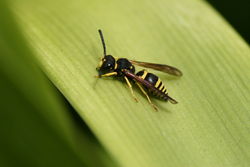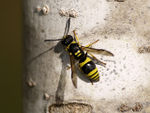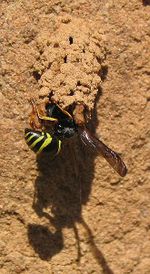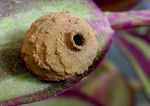European tube wasp
| European tube wasp |
|---|

|
| Scientific Classification |
|
| Binomial Name |
|
Ancistrocerus gazella |
The European tube wasp (Ancistrocerus gazella, is also referred to as the Potter wasp or the Mason wasp. It's known for its spherical, pot-like nests which it creates for the development of its offspring. The distinctiveness of this species lies mainly upon the shape of its nest.
These wasps go through the common growth of complete metamorphosis and, like many other species in its family, the females tend to be larger than the male. The females do most of the work their entire lives whether it be to care for their larval offspring or to hunt for food. This species is definitely a wonderful and unique creation with intricate life systems and designs.
Body Design
These wasps consist of a head, thorax, and abdomen from anterior to posterior. Their common body color is black and yellow. They contain compound eyes, six jointed legs, and two antennae. Their waist, also known as the petiole, separates the abdomen from the thorax. They also have two pairs of transparent wings and an external exoskeleton to protect and support its body.
Their digestive system consists of a foregut, midgut, and hind gut. It automatically extracts nutrients from the food the wasp consumes. Their food is broken down into small, complex substances by catabolic reactions, in which cells and molecules are broken down and produces energy. Their energy distributes for growth and reproduction. Without any veins or arteries, the wasp has an open circulatory system. The blood flows freely through the body. However, one single blood vessel runs along from the head to the abdomen. It forms the insect’s heart. The heart contains holes in its wall called ostia, which allows blood to enter. [2]
Females are typically larger than the males. The female wasps reach 11-15 millimeters. The front of its head is marked with yellow as well as the sides of its head. Their ventral side is yellow as well. However, their entire thorax region and antennae are black. Owning an ovipositor, the female has a stinger and the male does not. [3] The male grows to be 7-9 mm. Like the female, the male also has yellow markings. The male proves to be more rounded in the abdomen and more convex. [3]
Life Cycle
The male wasp produces sperm and mates with the female wasp in any season except for winter. The male goes on to top of the female to fertilize the female’s eggs. The female wasp contains a stinger which is considered its ovipositor (the reproductive organ which allows reproduction to occur). [3]
The female collects and hunts several insects which it places into a tube/pot-like nest she has built out of mud along with larval offspring. The offspring hatches within a few days and feeds on the prey the mother provides for it within one week. The offspring begins to spin a cocoon and pupation then begins to occur. The wasp experiences complete metamorphosis. [4] When ready, the mother moistens a portion of the nest to create an opening for the offspring to exit. [5]
The parent wasps don't remain with the offspring resulting with no interaction between parent and offspring whatsoever. These wasps repeat the same cycle of reproduction over and over again until death. Cite error: Invalid <ref> tag; invalid names, e.g. too many
Ecology
Although Tube wasps were introduced in New Zealand, they are distributed mostly in the main European lands such as Norway, Sweden, The Netherlands, France, Spain, Germany, Italy, Poland, Austria, Ukraine, Romania, and Bulgaria. [5] Some are found in Eastern Canada (Ontario) and the United States (New York). They may also be found in Afghanistan and Northern Africa (Morocco). They were first located in the United States (New York) before 1961. [6]
Its habitats normally revolve around cavities located in humid areas, such as river banks, and soil enriched locations, such as woodlands. The types of flowers visited by this species includes Sea-holly, bramble, thistles, and hogweed. Interaction between this species and other species is very low. They are independent organisms who only interact with the opposite gender when reproducing. [5]
Nests
How is the nest built? Having no help from the males, the female alone builds a pot-like nest for the growth of its offspring. The mother wasp must first find an area appropriate for her nest. Areas such as natural holes or cavities work perfectly and are preferred. The female then creates mud by mixing soil or dirt with water. Their saliva may also work as an option to hold the structure together.
What do they look like? These extravagant nests resemble pots therefore giving the wasp the name Potter Wasp or Tube Wasp. They are rounded with thin necks. Unlike many other species of its order that live in colonies (homes containing many of its species), the potter wasp lives alone and only interacts with wasps to mate and reproduce. Because the wasp lives alone, the nest tends to be smaller than typical nests of its order. However, the nest is large enough to fit one potter wasp. Cite error: Invalid <ref> tag; invalid names, e.g. too many
Video
The tube wasps, also known as potter wasps, mating.
References
- ↑ Unknown. Ancistrocerus gazella Wikispecies. Web. Last updated 15 November 2012.
- ↑ Unknown. Potter Wasp Weebly. Web. Date accessed 17 December 2013.
- ↑ 3.0 3.1 3.2 Unknown. Taranaki Educational Resource Research Analysis and Information Network Terrain. Web. Last updated 22 January 2013.
- ↑ Unknown. Wasps, Bees, and Ants BioKIDS. Web. Date accessed 13 January 2014.
- ↑ 5.0 5.1 5.2 Unknown. Ancistrocerus gazelle (Panzer, 1798) BWARS. Web. Year profile last updated 1998.
- ↑ Buck, Matthias. 7. Ancistrocerus gazella (Panzer, 1798) Canadian Journal of Arthropod Identification. Web. Last Updated 19 February 2008.




